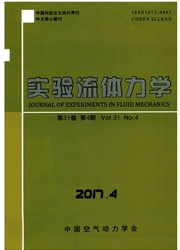

 中文摘要:
中文摘要:
粒子图像测速技术目前已经发展成为实验流体力学领域应用最广泛的非接触激光测试方法之一,为认知复杂流动机理提供直观的流场信息。本文基于超声速流场PIV技术研究实践,针对示踪粒子布撒器设计、粒子松弛特性模型构建、激波流场测试分析、超声速平板湍流边界层结构分析等方面具体问题的研究和认识,从理论、定量化的角度深入分析了应用于超声速流场PIV技术现阶段依然存在的问题。从应用于超声速流场PIV技术的原理出发,针对高速复杂流场的PIV测试现状,总结了应用于超声速流场PIV技术发展过程中的光学部件、示踪粒子及布撒系统所遇到的一系列挑战,以及国内外利用PIV技术在高速复杂流场研究中所取得的成就,针对PIV技术能否适用于高超声速流场的测量做了系统化地探索。并根据实践经验提出了应用于超声速流场PIV技术未来的发展方向:通用的精确的PIV方法不存在,必须从具体研究的流动机理角度改造相应的PIV测试手段。
 英文摘要:
英文摘要:
Particle Image Velocimetry (PIV) has been developed to be one of the most extensively used non-contact laser-based methods for velocimetry measurements, which provides visible flow field information to study the high speed complex flow mechanisms. In the present paper, we summarize our researches on the tracers seeding, particle relaxation modelling, the flowfield of shock waves and supersonic turbulent boundary layer. From the perspective of theory and quantitative analysis, for the application of PIV technology in surpersonic flows, there are still many challenges to the optical devices, tracer particles as well as their seeding system and so on. Nevertheless, we have systematically studied the applicability and feasibility of PIV methods in supersonic flows in view of the principals of PIV technology and the current applications in supersonic flows. The results also demonstrate that PIV measurement is not always accurate, and thus the applications and developments of PIV technology in supersonic flows shall be subject to the flow features under research.
 同期刊论文项目
同期刊论文项目
 同项目期刊论文
同项目期刊论文
 期刊信息
期刊信息
